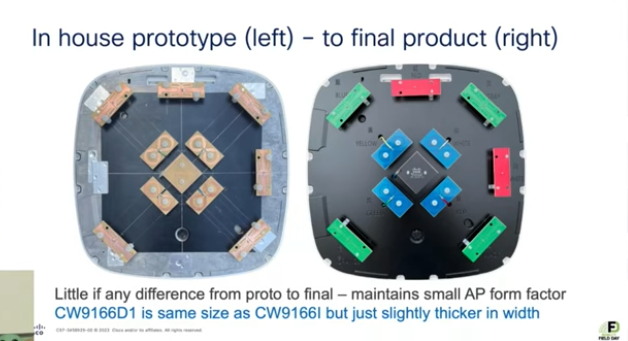Cisco does the “AFC Side Step” with the CW9166D1

Intentionally focusing RF propagation is a good thing but with more Wi-Fi Practitioners embracing focused antennas, there is still the reality that external antennas add to the cost and complexity of the installation. Some external antennas even cost as much as the AP itself, which can make for some awkward conversations with Layer 9 (Finance & Budgetary layer) when your design just doubled the hardware costs. Your design is unlikely to be approved by Layer 9 when they ask you to defend your decision and the answer consists of only, “Well, directional antenna make the Wi-Fi better”.
Wi-Fi practitioners need to speak the language of Layer 9 and translate “better Wi-Fi” into MBA speak with productivity gain ratios. With higher data throughput and less time waiting for data to transfer, employees can spend more time analyzing the data or responding to emails instead of waiting for the data to be transferred and displayed in their application. As an example, “better Wi-Fi” resulting in productivity gains of 15% easily provide Layer 9 the type of information they need to determine the return on investment (ROI) and justify the higher hardware cost outlay knowing the expenditure will be recovered in less than 1 month.
There has been much celebration over the recent allocation of the 6GHz band for unlicensed use. Unfortunately, 6GHz usage is complicated by existing incumbents, such as fixed wireless providers, satellites, and military use. As a result, the FCC decided to roll out approval of 6GHz in two waves – Low Power Indoor (LPI) and Standard Power (SP). LPI APs were approved for use immediately and most major enterprise Wi-Fi vendors have at least one model of AP that can be purchased today and operate with a 6GHz radio. SP is a little more complicated due to the operating parameters and require an Automated Frequency Coordination (AFC) program which has not fully been approved and implemented in the US. Many other regulatory bodies are waiting for the US to implement their AFC, so that they can align cross border signal propagation.
The differences between LPI and SP are outlined in the table below; some key differentiators are external antennas, higher transmit power, and outdoor operation.
| Low Power Indoor (LPI) | Standard Power (SP) | |
|---|---|---|
| Spectrum | 1200MHz (UNII 5/6/7/8) | 850MHz (UNII 5/7) |
| Environment | Indoor ONLY | Indoor or Outdoor |
| Weatherized AP | No | Yes |
| Antennas | Internal/Integrated ONLY (no connectors) | External supported |
| AP Transmit Power | 5 dBm/MHz | 23 dBm/MHz |
| Client Transmit Power | -1 dBm/MHz | 17 dBm/MHz & 6 dBm below AP |
| Battery Power AP | No | Yes |
| AFC required | No | Yes |
As external directional antennas are not allowed indoor or outdoor until AFC is in place, the options available to design in RF challenging environments such as warehouses, manufacturing, or large public venues has been somewhat limited to mostly omni-directional antennas.
Cisco has managed to side step the AFC program by introducing the CW9166D1 at Mobility Field Day 9 (MFD9) – a redesign of the CW9166i front end to now include an integrated directional antenna. By including an internal antenna while also operating in LPI mode, AFC requirements can be side stepped as there is no external antenna. This means Wi-Fi Practitioners can take advantage of directional focused antennas today when implementing 6GHz networks and do not have to wait for AFC programs to launch in regions where 6GHz is already permitted.

This slide shows the directional focused beams now available with the CW9166D1. The 2.4GHz and 5GHz band radios both support 70 x 70-degree horizontal (azimuth) and vertical (elevation) beamwidths, with a 60 x 60-degree beamwidth when using the 6GHz radio.

With careful antenna design, the CW9166D1 is only 10mm taller (thicker) than the CW9166i while keeping the same X-Y dimensions. The CW9166D1 is also capable of running in dual 5GHz mode allowing Wi-Fi practitioners to future proof their designs until 6GHz is available in their region. Alternatively, those regions with 6GHz support can operate in dual-5GHz mode and wait to enable the 6GHz radio once client support reaches critical mass. Below is an image of the near final antenna design for the CW9166D1:


Here is summary of the ports available on the CW9166D1 with the D1 including a port for optional DC input power. 802.3af is not supported and support for the USB port is lost when running on 802.3at power. For full performance, 802.3bt based PoE is required.


To keep installation simple and allow Wi-Fi practitioners to aim the RF where it’s desired, a new articulating arm will also be released which supports up/down and left/right adjustments to simple ceiling or wall mounting options. The long-supported AIR-AP-Bracket-1 and AIR-AP-Bracket-2 (shipped by default) can be used to attach to the articulating arm.

The CW9166D1 is a welcome option for Wi-Fi Practitioners providing a much-desired ability to focus and spotlight RF energy into intended coverage areas and we look forward to orderability in FY ’24 Q1 (or CY ‘23Q3 for those outside of Layer 9).
I am sure more details will be made available this month during Cisco Live, June 4-8, in Las Vegas, NV. Look for presentations from wireless legends Fred Niehaus or Jim Florwick.
Will I see you there?
Slàinte!
Resources
Latest AFC draft from FCC
https://apps.fcc.gov/eas/comments/GetPublishedDocument.html?id=506&tn=150793
Cisco CW9166 Data Sheet
Meraki CW9166 Data Sheet
https://documentation.meraki.com/MR/MR_Overview_and_Specifications/CW9166_Datasheet
Cisco Presents at Mobility Field Day 9
Cisco Presents at Mobility Field Day 9 – 9166D1 Video (Youtube)